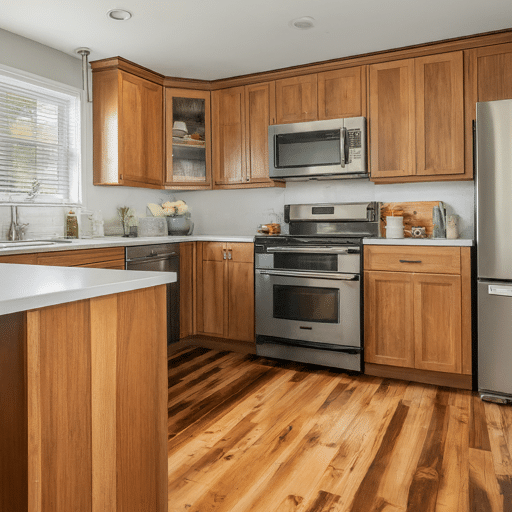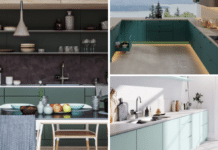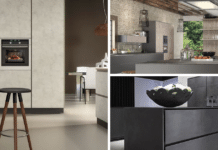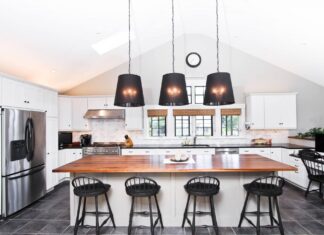If you’re remodeling your kitchen, your chosen flooring will play a big part in the finished look. However, there are countless options, so it’s easy to feel overwhelmed.
With this in mind, we’ve compiled a detailed guide to help you narrow down your choices. From hard-wearing tile and natural stone options to modern vinyl and laminate, we’ve listed some of the most popular materials, along with some pros and cons.
There are also some helpful installation and maintenance tips so you can choose kitchen flooring that’s perfectly suited to you, your home, and your choice of cabinets!
Flooring For a Kitchen Must Be Hard-Wearing
Your kitchen needs tough flooring more than any other room in your home. In addition to traditionally seeing a lot of foot traffic, kitchen floors are also far more likely to experience spills, scratches, and temperature fluctuations.
It’s also worth remembering that kitchens tend to get cleaned more regularly than other rooms – often with fairly harsh chemicals.
With all this in mind, you’ll want to find kitchen flooring that’s extremely durable, easy to clean, and will still look great if you have an accident with a pan of water or a sharp utensil.
Here are 6 kitchen flooring options that won’t let you down:
1. Linoleum Kitchen Flooring

Back in the 1950s, linoleum was everywhere.
From domestic kitchens to hospital wards, linoleum was a tough, stain-resistant, and anti-microbial option that was perfect for a huge range of flooring applications. In truth, linoleum only really fell out of fashion because plastic-based products hit the market.
Although these newer products were fashionable for a while, linoleum has never really gone away—and today, it’s firmly back in fashion, thanks in part to its natural, eco-friendly, renewable materials.
Pros
- Price — One of the biggest advantages of a linoleum floor is its low cost, both for the materials and the fitting.
- Stain resistance — Despite being made with natural materials, linoleum is incredibly stain-resistant.
- Non-absorbent — Don’t panic if you drop liquids or sauces – linoleum kitchen flooring won’t absorb anything; making cleaning quick and simple.
- Biodegradable — There has never been such a strong focus on environmental issues. Linoleum is generally made from 100% natural materials, all of which can be recycled and will naturally break down after use.
- Maintenance — Linoleum is a real’ fit and forgets’ kitchen flooring option, with no need for intensive cleaning, sanding, refinishing, or adjusting.
Cons
- Easily dented and scratched — Linoleum isn’t very tough – so even though it will cope with plenty of foot traffic, it won’t stand up to heavy impacts or sharp utensils very well.
- May fade — Depending on the color you choose, linoleum can sometimes fade if it’s exposed to lots of strong, direct sunlight. This won’t be a problem for everyone, but if you live in a warm state, it’s something to consider.
- Resale value — Not everyone loves the look of linoleum, so choosing it over a more popular premium kitchen flooring option like tile or stone may attract a lower resale value.
2. Laminate Kitchen Flooring

Laminate floors for kitchens have long been a favorite option. They’re a great-looking, easy-to-install option that resembles stone or hardwood but without the price tag.
Choosing laminate for your kitchen floor opens up many finish options. Some laminate kitchen flooring is designed to look like wood and fit together with a pronounced join between each board – giving the impression of traditional wood flooring.
If you don’t like the wooden effect, you could choose a plain color. Picking a single color will make the seam between planks virtually invisible, giving your kitchen a modern, sophisticated look.
Pros
- Low maintenance — Since it needs no sanding or refinishing, laminate flooring can offer the look of a real wood floor with none of the maintenance.
- Durable — The upper layers of laminate are designed to provide tough, clear protection, making it a long-lasting option that will look good, even in a busy kitchen.
- Stone or wood effect — Laminate can replicate expensive stone or wood-effect planks or tiles, giving a premium flooring look for a fraction of the price.
- Installation — Laminate is one of the easiest flooring options to install. There’s no adhesive involved, and the sections generally just snap together.
Cons
- Not waterproof — Although laminate generally handles spills, it’s not fully waterproof. If moisture gets into the joins between planks, it can cause the boards to swell and crack.
- Cleaning — Many laminates need a specific cleaning solution. The laminate cleaner isn’t expensive – but it is essential, as mopping could cause moisture to creep between the planks.
- Resale value — Laminate doesn’t have the same appeal as genuine stone or wood so that it may affect your resale value slightly.
3. Hardwood Kitchen Flooring

Very few kitchen floor options have the timeless good looks of hardwood flooring. As fashions come and go, hardwood remains, and its universal appeal means it often adds value to any home it’s installed in.
It’s not just the look that’s popular, either—hardwood can be easily refinished, so if your kitchen flooring looks tired, it can be easily renovated and returned to looking its best.
Hardwood isn’t the cheapest option on this list – but when you consider how tough and long-lasting it can be, it’s a kitchen floor option that could last you a lifetime.
Pros
- Attractive — Hardwood flooring looks fantastic – and it’s a look that never goes out of fashion.
- Tough — As the name suggests, hardwood is extremely durable and can easily withstand knocks and bumps.
- Long-lasting — When looked after properly, real wood can last for decades – or even centuries!
- Resale value — Real wood flooring is highly desirable and will almost certainly increase your home’s resale value.
Cons
- Cost — Desirable, tough floors come with a price tag, and natural wood is likely to be the most costly flooring option for your property.
- Upkeep — If you have hardwood in your home, you’ll need to maintain it to keep it looking great. This can involve sanding, re-staining, and varnishing it at least every 10 years.
4. Concrete Kitchen Flooring

Although the word ‘concrete’ might inspire thoughts of functional grey architecture, it’s actually an amazingly versatile flooring option that’s becoming a favorite in modern kitchens.
If you have a ground-floor kitchen, there’s a chance you have a concrete subfloor under your current flooring.
Sometimes, you’ll need a final top layer of concrete to finish the look, but concrete can be treated and polished to create an ultra-tough, attractive kitchen floor, even if you’re working with a tight budget.
Concrete isn’t a look everyone loves, but it can be especially striking when paired with minimal Euro-style cabinets, especially in a high-gloss finish.
Pros
- Tough — There aren’t many flooring options tougher than concrete! Concrete easily withstands heavy bumps and is very unlikely to scratch.
- Low maintenance — When concrete is installed and finished properly, it will likely last for years with virtually zero maintenance.
- Versatile — Concrete can be finished in many different ways, so whether you’d like a high-gloss shine, a tough industrial look, or anything in between, it’s almost certainly possible.
- Long-lasting — Even with minimal upkeep, a concrete floor can last a lifetime.
- Cost — Concrete is generally a cost-effective flooring option – both from a materials and installation point of view.
Cons
- Very hard — Being tough comes with a slight comfort downside. Concrete is very hard, and it can be uncomfortable to stand on for long periods; especially in socks or bare feet.
- Installation — Concrete is difficult to install, often involving numerous layers with lengthy drying times in between.
- Can stain — If concrete isn’t finished properly, it can stain, which will be impossible to remove without refinishing the floor.
- Some finishes are costly — Not all concrete floors are cost-effective. If you opt for a high-design finish, the installation cost can increase significantly.
5. Vinyl Kitchen Flooring

Vinyl flooring has generally been considered a low-cost and often low-quality flooring material for kitchens – but today, a new generation of vinyl has changed that perception.
Modern vinyl used for kitchen floors is often called ‘luxury vinyl flooring’—or LVF. Out of the box, a vinyl plank or vinyl tile looks quite similar to laminate flooring, but a vinyl tile is actually 100% synthetic, giving it superior resistance to moisture.
Like laminate, the construction method used to create vinyl flooring means a wide range of finishes are available—printed and embossed on a sheet that is then covered with multiple wear layers and a no-wax, tough polyurethane top layer on the plank or tile.
Pros
- Moisture resistance — Whether you opt for LVF or lower-cost sheet vinyl, you can be assured that it will be 100% water-resistant—even for major spills and leaks.
- Cleaning — Vinyl flooring’s tough plastic finish makes it quick and easy to clean. It’ll stand up to virtually every cleaning product on the market.
- Durable — Plastic might not be the best for the environment, but it lasts long. No matter how much traffic your kitchen sees, vinyl will stand up to it and look good.
- Installation — Like laminate, vinyl is easy to install. Sheet vinyl can be cut to size from a template, and each vinyl tile is designed to snap into place quickly and easily.
- Cost — Vinyl is very cost-effective – and even LVF options are more affordable than wood or stone tile alternatives.
Cons
- Plastic — Vinyl flooring uses layers of plastic, so it doesn’t have the environmental benefits of natural stone tile, wood, or linoleum.
- Quality can vary — There’s a big difference in the quality of vinyl options on the market. Make sure you compare to ensure you’re getting the best product for your money.
- Lifting — Vinyl needs to be stuck to the subfloor with an adhesive, making it tricky to remove if you decide to replace it.
6. Ceramic Tile Kitchen Flooring

For a long time, ceramic tiles were one of the most popular kitchen flooring options worldwide. Drawing from South Europe and North Africa, vibrant, colorful designs could add personality to even the dullest and most functional kitchen.
Tiles fell out of fashion for a while, but they’re a firm favorite again now, with a huge range of designs available. You can find natural stone-look tiles, high-gloss plain colors, patterned tiles, and many more. There’s almost certainly a tile out there that will suit your home!
The grout that’s used to fix your tiles isn’t off-limits for the design-minded either. Although grout is traditionally white or naturally colored, black or colored grouts can be used to add a bit of extra detail to flooring in kitchen areas.
Pros
- Water-resistant — Both ceramic tiles and the grout used to install them are highly water-resistant.
- Low maintenance — When tiles are fitted, they can generally be forgotten, aside from ensuring the grout stays clean.
- Design options — From stone tiles to bright, eye-catching designs, there’s a tile for every home.
- ConsHard — Tile kitchen flooring is notoriously hard – so it can be a little uncomfortable underfoot for long periods of time.
- Cold — Tile floors and stone tiles can be quite cold – as they don’t naturally retain warmth like wood flooring.
- Installation — If you’ve ever tried to cut a tile, you’ll know it’s a job best left to a professional. This can push installation costs up compared to DIY alternatives.
Which of These Kitchen Flooring Options is Right For Your Home?
Every home is unique, so what’s right for you might not suit another kitchen in a similar property.
When you plan to remodel your kitchen, it’s useful to consider your budget and get the best deals. Flooring can take up a large proportion of your spending, especially considering a premium option.
If you still can’t decide after considering the pros and cons listed here, why not contact our design team? We can use our specialist software to show you how your ideal kitchen could look with various flooring options.








